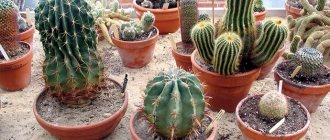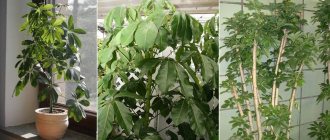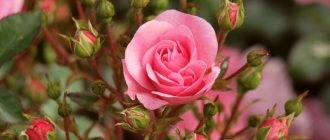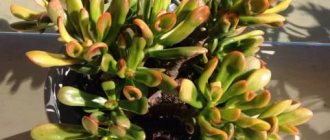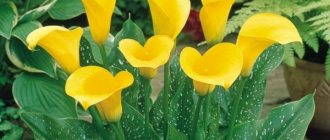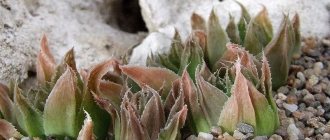Encyclopedia of Succulents
Cacti are prickly bushes that previously impressed almost no one. But now the fashion for these plants has become so popular that almost every gardener is ready to take on growing such crops. This is not surprising, because ease of care and attractive flowering do everything to make these plants become more and more popular. The Gymnocalycium cactus has an original appearance and incredible flowers. This article is devoted to the features of planting, caring for such a bush, as well as varieties of culture.
- 1 Description of the cactus genus Gymnocalycium
- 2 Gymnocalycium cactus: home care 2.1 Features of culture transplantation
Description of the cactus genus Gymnocalycium
The Cactus genus Gymnocalycium is a representative of the Cactus family (Cactaceae). Their distribution area is Argentina, part of Uruguay, Paraguay, part of Bolivia and Brazil. The name comes from the Greek words "gymnos", meaning "naked" and "kalyx", meaning "bud".
This crop is a perennial plant with a dense root system. Representatives of this genus are characterized by an incredible variety of shapes, shades, volumes of stems, and flowers. A large number of flattened balls are formed on the surface of the bush. The stem has a diameter of up to 0.15 meters, the height of the crop is up to 7 cm. The skin is in most cases glossy and has a dark green color. Under natural conditions, brown stains are observed on the surface of the stem.
Gymnocalycium in natural conditions
Flowering of bright bushes occurs in the period May-November. The buds are located at the top of the stem, which adds special charm and unreal beauty to them. The calyxes are closed, there are no spines on them, and there is also no pubescence. The flowers are usually bell-shaped with lanceolate-type petals. The petals can be colored in yellow, cream shades, and there are also variants of red and crimson tones. The flower reaches up to 7 centimeters in volume.
At the end of flowering, fruits with an ovoid configuration are formed on the bush. They are usually covered with minor scales. The length of the red, green or purple berry is up to 4 centimeters.
Gymnocalycium cactus: home care
The first thing that is necessary for proper and comfortable growing of a plant is the optimal soil composition. The best soil is based on turfy, leafy soil, with a large amount of peat, sand and humus. All components are prepared and taken in equal proportions. Also, to improve the composition, you should add a little charcoal or brick chips to the mixture.
Photos of cacti Gymnocalycium Mihanovicha
The Gymnocalycium cactus prefers bright sunlight. It should be present on the windowsill in summer and winter. But remember that exposure to direct sunlight has a detrimental effect on the condition of the thorny bush.
It is also extremely important to maintain comfortable temperature conditions. In summer, an indicator of +21...24°C is suitable. When the warm period ends, it will be necessary to reduce the readings to +16°C. This type of cactus can withstand temperatures down to -5°C. Any air humidity is suitable; no additional spraying is needed.
To see blooming gymnocalyciums, they will need to choose the optimal watering. In spring and summer, this procedure is performed very carefully and sparingly. Remember the unspoken rule - the next watering is carried out only after the soil around the bush is completely dry. To moisten the composition, it is recommended to use water at room temperature, but always slightly settled. When summer is over, watering is carried out extremely sparingly.
Feeding also plays a big role. For fertilizer, it is better to use complex compounds suitable for cacti. Soil enrichment is carried out once a month. During the dormant period, no nutrients need to be added.
Features of culture transplantation
Proper care of the Gymnocalycium cactus also involves timely transplantation. It is recommended to perform this procedure once every 2-3 years. The optimal period for transplantation is spring. To complete the process, select a container that is larger than the previous one. It is better not to completely remove the earthen ball of the root system, but only superficially update the soil. When planting is carried out, the bush should be limited in watering. Irrigation is resumed only after 7 days.
Gymnocalycium Andre
Growth:
Provinces of Cordoba and San Luis in northern Argentina. Gymnocalycium Andre lives on the peaks of the Sierras de Cordoba mountain range at altitudes of 1500–2000 m above sea level. The cactus grows in rock crevices, as well as in humus-rich areas among grasses. The climate in these places is quite humid, with frequent showers and fog throughout the year and snowfalls in winter.
The plant is named after the famous German cactusist Wilhelm Andre.
Description of the plant:
Plant size and type:
Gymnocalycium Andre is a small prickly cactus, barely rising above the soil surface, usually solitary, but in cultivation it often branches and forms groups up to 15 centimeters wide or more. This species differs from other Gymnocalyciums in the color of its flowers. In Gymnocalycium Andre they are shiny, greenish-yellow in color.
IN THE PHOTO: Usually solitary, Gymnocalycium Andre can form entire colonies of low-growing miniature cacti.
Stem:
The stem is spherical or hemispherical, up to 5 cm in diameter, usually with a depressed apex, dark bluish-green or black-green with a bronze tint.
Root:
The root is large, the root system is taprooted.
Ribs:
The ribs range from 8 to 13, they are straight, smooth, divided into convex round tubercles by thin intersecting grooves. There are no protrusions.
Spines:
There are 9–13 spines, all 1–1.5 cm long or shorter.
IN THE PHOTO: A cactus with spreading radial spines and slightly curved central spines.
The radial spines are thin, spreading, 6–9 of them are directed horizontally, one goes down, similar to the central ones, dull white or yellow-white, with a chestnut tint at the base. There are from one to three central spines; they are thin, needle-like with a slightly curved tip, hard, dark brown in color.
Flowers:
The flowers are bell-shaped to funnel-shaped, 2.5–4 cm long and up to 5.5 cm in diameter, bright, yellow, silky. Without tube or with very short tube. The outer segments of the perianth are light greenish-yellow in color with darker green stripes in the center. The inner tepals are light, sulfur-yellow in color, narrow to almost spatulate. Pistil stigma with eight lobes. The anthers are yellow.
IN THE PHOTO: Gymnocalycium Andre is one of the few representatives of the genus with yellow flowers.
Flowering period:
Flowers appear in early summer.
Fruits and seeds:
The fruits are spherical to cylindrical, blue-green, approximately 1.2 cm in diameter. The seeds are black, matte.
Varieties:
Gymnocalycium andreae subs. carolinense
It is distinguished by white, sometimes pink flowers that emit a sweetish aroma, as well as light brown spines with creamy brown tips.
Agricultural technology:
Gymnocalycium Andre is a summer growing and easy to care for species. This is one of the most frost-resistant cacti in South America. Can withstand temperatures down to –15°C and below. It grows relatively quickly and blooms easily, and in good conditions it forms groups.
Lighting:
This Gymnocalycium tolerates very bright light well, but loves diffused light or shading during the midday hours. If the cactus is growing indoors, it needs bright light and at least some direct sun. In bright light, the cactus takes on a bronze tint, blooms well and forms powerful thorns.
Watering:
In summer, watering is moderate to abundant, but waterlogging should not be allowed, as the cactus is prone to rotting. Wintering is dry.
Fertilizer:
In summer, the plant is fed with high-potassium fertilizer.
Substrate:
Gymnocalycium Andre loves loose soil with a low (about 5) pH value. Substrates rich in limestone should be avoided, otherwise the cactus will stop growing. The plant should be planted in a pot with good drainage.
Rest period:
If the cactus is kept dry in winter, it can withstand short-term temperature drops to –15°C. But the optimal temperature in winter is +8–10°C.
Diseases and pests:
The cactus may attract some pests, but if it grows in a mineral soil mixture, with good lighting and ventilation, then the plant is usually free of pests. However, it is worth paying attention to the following pests.
Red spider mite
They can be effectively destroyed by spraying the plant.
Mealybug
These pests can sometimes be found on young areoles, but it is worse if the scale insects reproduce on the roots, where they are not visible, but only the results of their activity are visible.
Shchitovka
Scale insects rarely attack this cactus.
Rot
Rot rarely appears with proper watering and good ventilation.
Reproduction:
By division or seeds.
Seeds are sown in the spring after the last frost. They germinate in 7–14 days at a temperature of +21–27°C. After about 1–2 weeks, when the seedlings have taken root well, the transparent lid from the container should be gradually removed in order to accustom the young plants to fresh air. Full sun is harmful to seedlings. When dividing a plant, you need to carefully break off the shoot and let it dry for a couple of weeks, after which you need to place the cutting in the soil, slightly deepening its end. The cutting must be held vertically so that the roots grow downward. Editorial team LePlants.ru
How to propagate the Gymnocalycium plant
The Gymnocalycium cactus reproduces both vegetatively and by seed. A simpler method is propagation using lateral shoots. Once formed shoots will need to be unscrewed from an adult plant, left to dry for 24 hours, and then carefully planted in a sandy substrate. To strengthen the seedling, it is recommended to support it with matches. You can observe the appearance of the root system within a few days, provided that the procedure is performed in the spring. If such a process is carried out in winter, then additional illumination of the crop will be required.
This video shows the process of separating the side shoots of one of the types of Gymnocalycium
If Gymnocalycium seeds are used for propagation, then prepare a special container with a composition based on peat and sand. First, the mixture is placed in the oven so that it is well calcined. The seed material is carefully laid out on the soil, then lightly covered with soil. The container is covered with cling film when it is removed after the seedlings emerge. Be sure to ensure that the soil does not dry out. If you adjust the air temperature to +20°C, you can observe the first shoots after 10-12 days. It is recommended to replant the bush only after 1 year.
Note! The cactus Gymnocalycium Mihanovicha is propagated by grafting. It can be grafted onto any other green, thorny crop. A horizontal cut is made on the rootstock, and the same is done with the scion. The specimens are pressed securely and fixed with a bandage that has a certain weight. After 7 days the bushes grow together.
Pests and diseases
Most often Gymnocalycium affects:
- Scale insects - attack the root system of the plant, and the development of the cactus stops. To combat scale insects, insecticidal preparations (actara) and treatment with isopropyl alcohol are used.
- The mite rarely affects Gymnocalycium, but causes significant harm. To get rid of ticks, the affected areas must be washed with warm water, treated with alcohol or sprayed with an acaricide, for example, Karamaito.
- Root rot - can occur if the plant is not cared for properly. Cacti stop blooming, stop growing and may die. To prevent the death of the plant, the affected roots must be removed, and the remaining healthy ones must be disinfected (Decis, Karate) and transplanted into a new pot with fresh substrate.

